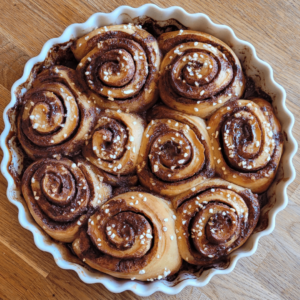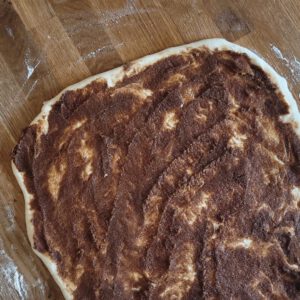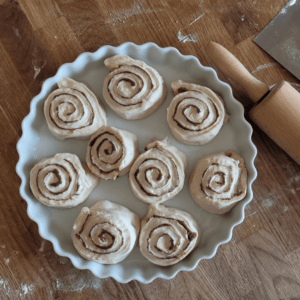
Soft Sourdough Cinnamon Rolls Overnight
With this recipe you can make soft and fluffz cinnamon rolls without needing any yeast or eggs. A tangzhong binds extra moisture in the dough and together with the sourdough ensures that the cinnamon rolls remain fresh and juicy for longer. The sourdough also makes them fluffy. Your starter does not need to be freshly-fed, but the last time it got fed should not be more than five days ago. Without the taste of industrial yeast all the other aromas will be able to take the stage. For the dough, you can use real butter or a plant alternative if you prefer a vegan alternative. You can prepare the dough on the day before and let it rest overnight in the fridge. The long fermentation time increases the aroma.
Ingredients
tangzhong
- 100 g water or milk (plant-based alternative)
- 20 g wheat flour
Ingredients for the Dough
- tangzhong cooled
- 500 g wheat flour all purpose flour (or type 550)
- 240 g water
- 50 g sourdough starter
- 60 g butter or vegan butter
- 30 g sugar
- ½ tsp. cardamom
- 1 pinch salt
Ingredients for the Filling
- 100 g brown sugar
- 70 g soft butter or vegan butter
- 2½ tsp. cinnamon
- ½ tsp. cardamom
- 1 pinch salt
Instructions
Day 1
- For the tangzhong, mix 20 grams of flour with 100 grams of water in a pan and bring to the boil briefly until a firm paste forms. Leave the tangzhong to cool completely.
- Then mix all the ingredients together to form a homogeneous dough. Cover the dough and leave to rest at room temperature for six hours. Stretch and fold once after the first 30 minutes.
- Leave the dough to rest in a covered bowl overnight or for 12 hours in the fridge.
Day 2
- For the filling, mix together the sugar, cinnamon, cardamom and salt.
- Add the filling: remove the dough from the fridge and roll out on a floured work surface to form a rectangle, approx. 30 x 40 cm (10" x 15") in size. Brush the dough sheet with the soft butter and sprinkle generously with the cinnamon filling.

- Roll up and cut out: roll up the dough tightly. Then cut it into nine equal-sized cinnamon rolls. This works best with a thin thread.
- Place the cinnamon rolls with a little space between each other in a greased oven dish and leave to rest for another 1-2 hours at room temperature.

- Bake: preheat the oven to 180°C (350 °F) with circulating air. Brush the cinnamon buns with (oat-) milk and sprinkle with coarse sugar. Bake the rolls for about 30 minutes until golden brown.
- Serve the freshly baked cinnamon rolls warm after letting them cool down for a bit.

Notes
Variations
The sourdough cinnamon buns don't really need any extras, but if you want a little IKEA experience, sprinkle the sweet buns with coarse sugar before baking. If you like it extra sweet, you can also give the cinnamon buns a sugar glaze or a creamy cream cheese frosting.Why aren't my cinnamon buns rising?
If the sourdough cinnamon rolls don't rise, it can have different reasons. One possibility is, that the dough had too little moisture. If you use another flour type as in the recipe, you might need to adjust the amount of water too. Wholegrain flour, for example, takes up more water than light cake flour, and if the dough is too dry it misses the necessary elasticity to rise. All flours are different, so you may need to use more or less water than stated in the recipe. Another reason may be that the sourdough starter is not active enough. Your starter does not need to be freshly fed for this recipe, but the last feeding should not have been more than five days ago. Don't worry - if your starter doesn't have enough power, you can make up for it with more time. Yet another important factor to consider is the room temperature. If the dough is left to rest in a cold place, the fermentation process slows down considerably. The optimal temperature of the surroundings should be between 24 and 26°C (75 and 78°F). Your dough needs more time at cooler temperatures.Why do the cinnamon rolls become hard?
One possible reason is, that the baking temperature is too high or the baking time too long. This causes the cinnamon rolls to dry out and harden. Too much flour in the dough can also cause the cinnamon rolls to become hard. Try to roll out the dough using as little flour as possible. My tips for soft and fluffy cinnamon rolls:-
- Using steam when baking: steam ensures that the dough has enough time to rise in the oven, before a crust develops. This will cause the cinnamon rolls to become fluffy.
-
- Avoid underfermentation: in my experience, sourdough recipes are more often underfermented than overfermented. Especially dough with butter needs a lot of time to rise. If you are unsure, if your cinnamon rolls have been given enough time, rather wait another hour longer.
-
- The right amount of space between cinnamon rolls allows them to grow together and and therefore have as little crust as possible. Between the cinnamon rolls there should be 2-3 cm of space (about an inch), for them to grow.
Why do cinnamon rolls seep out?
It is normal that the filling seeps out a bit. If you are baking the cinnamon rolls in a tray, the sweet syrup mostly gets absorbed again. In order not to lose too much filling, you should take care not to allow the butter to become too warm before baking. Also, it can help if you reduce the amount of filling and spread it evenly. As a precaution, place the baking tray into or above a larger tray, so that the filling does not drop into your steam tray at the bottom of the oven.What flour to use for cinnamon rolls?
-
- All-purpose flour: this flour is ideal for cinnamon rolls, because it contains sufficient gluten for an elastic, easy rising dough.
-
- All-purpose spelt flour: you can also use this recipe with spelt flour. Spelt can't take up as much water as wheat flour, so I suggest reducing the amount of water.
-
- Wholegrain flour: if you want to replace a part of the flour with wholegrain flour, you need to increase the amount of water, because wholegrain flour can take up more water.